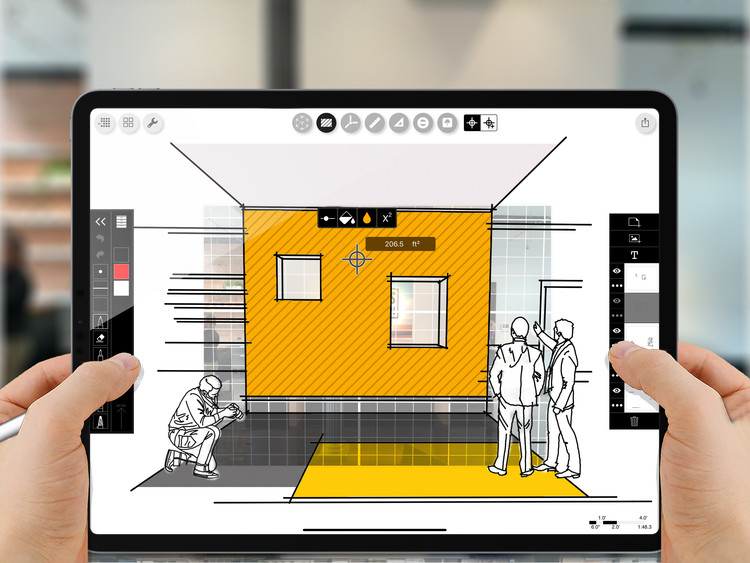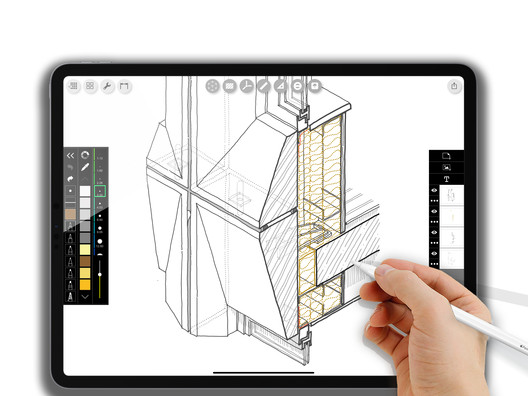
Can tablets help architects better conceive and execute their designs? If you’re skeptical, you’re not alone. To a certain extent, architects are still unsure if meaningful work can be created on an iPad. As the novel of virtual reality wears off, it’s worth asking if portable augmented reality is the push forward that will combine the best of traditional and digital architectural technology. So beyond their utility as lightweight, untethered screens, what can tablets offer the professional architect?
The iPad is an endless clean slate that appeals to creatives’ desires to sketch or illustrate in a way befitting of our time. Until 2015, with the launch of the first Apple pencil, users of Apple’s products could employ a third-party stylus but the inaccuracy and discomfort of these tools proved hopeless as practical or useful architectural drawing implements. As a result, there was no industry-wide surge in the adoption or demand of iPads for architects.
Flash forward to 2018, eight years after the initial launch of the iPad. The capabilities of the hardware itself have increased and the integration of ARKit have heightened the appeal of these devices for architects. And, evolving in step with the device are the softwares that ultimately determine the iPad’s utility, like Morpholio's TracePro.
Alongside other apps like ProCreate and Shapr3D, TracePro's app developers are hoping to harness the most ideal way to create in a way that doesn’t feel completely overtly computerized. The challenge is to take known technologies (even those with thousands of years of history) and put them into the digital world. Morpholio sees themselves as pioneers who are proposing how we will leverage the power of AR relative to architecture, and Mark Collins, Co-Creator of Morpholio, said, “we're trying to hit that perfect hybrid between the best of what we’ve relied on for centuries versus what's coming next with these devices."

We’ve covered many architectural apps that also seem to herald a breakthrough for architects, but the claims are made without convincing examples of how practicing architects are employing new apps and technologies for fruitful ends. Yet if you turn to Instagram you can see intriguing examples of how designers are taking advantage of their iPads (and Morpholio’s products specifically) to create useful and attractive visualizations.
In addition to the examples of what people are currently creating, there are legitimate reasons for considering that, at this moment, the tablet has a promising future as a fully-integrated tool in the architect’s workflow.
As TracePro blazes the trail for creating architecture on the iPad, it is bolstered by the iPad’s following features: portability and speed, the new pencil, and the ARKit API that takes advantage of the powerful camera. The larger format of the iPad (the 12.9 inch model), weighs in at 1.39 pounds and is more powerful than the entry-level MacBook. Its powerful A12X Bionic chip allows for the heavy duty computing that drives a seamless experience when moving around 3D models and drawings. To ensure the Pencil’s log is imperceptible, the iPad picks up 240 signals per second to deliver a smooth drawing experience.
Of the multiple “cool” capabilities (like Smart Fill and Instant Scale), here are the top three seriously convenient and impressive features of Morpholio TracePro.

Perspective Finder
Using the built-in-camera, the Perspective Finder gives you real scale virtual grids with true vanishing points for what the iPad “sees”. The instant interpretation of existing spaces with on-screen guides makes accurate quick and dirty sketches (no matter what level of drawing skills you are bringing to the table).

Stencils
Stencils allow you to duplicate and work with a library of go-to notes, arrangements, and drawings. The concept of a stencil is nothing new in the field, but the app feature represents how even the most basic existing architecture technology (which allowed for automation in drawing) has a place in the digital world. The digital stencil is different from a typical CAD block, but it's one of those things you really have to feel to understand. The similarity between pen on paper and Pencil on iPad is particularly apparent as you apply different strokes and pressure to fill the stencil.

Drag’n’ Fly

With Drag’n'Fly, you can drag a 3D model into Morpholio and draw on top of it while still viewing the model and drawing as a 3D object, not just as a flattened image. This is made possible by a new file format created by Apple: USDZ. This AR-first format is built-in to TracePro and allows for models to be toggled around and used with different softwares. File compatibility is perhaps the most common stumbling block when dealing with 3D file workflows, and USDZ provides an efficient, easy way to send 3D models back and forth. There’s no need to move extensive libraries back and forth; the usdz file format includes the model’s geometry, scale, textures and colors (essentially, the things that makes visualizations realistic). For those not ready to switch up their file formats just yet, TracePro also handles OBJ files.

Those taking the plunge into the world of iPad and Morpholio TracePro will need to spend an additional $288 for what Apple itself calls “iPad essentials.” To really take advantage of the iPad as a drawing board, you are left with no choice: you’ll need the 2nd generation Pencil. Same story if you want to tap into the portability aspect; the Keyboard Folio is crucial. The keyboard feels great, handles fast typing and seamlessly pairs with the iPad. Once attached via magnet to the back of the device, the keyboard is ready to be used. The entire set up almost (almost, not quite) works like a laptop.
The iPad, and the apps which it facilitates, offer one avenue of progress for the future of design and representation. And TracePro alone isn't going to be the thing that makes architects switch over to iPad. With this in mind, Apple says it is focused on the needs of creatives and designers in broader terms, which means companies like Autodesk and Adobe are working on new iPad-optimized versions of their software.

This powerful constellation of tools has the possibility of spawning a different, more efficient, mobile and imaginative workflow. If it takes off, this new suite of apps will facilitate a design process that is as smart as it is soft and experiential. Since architects frequently welcome new technology, it's not hard to imagine a future of architecture firms filled with desktops, sketchbooks...and tablets.















